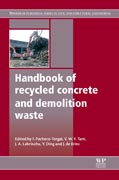
Handbook of Recycled Concrete and Demolition Waste
Pacheco-Torgal, Fernando
Tam, V
Labrincha, João
Dingeldey
de Brito, J
The civil engineering sector accounts for a significant percentage of global material and energy consumption and is a major contributor of waste material. The ability to recycle and reuse concrete and demolition waste is critical to reducing environmental impacts in meeting national, regional and global environmental targets. Handbook of recycled concrete and demolition waste summarises key recent research in achieving these goals.Part one considers techniques for managing construction and demolition waste, including waste management plans, ways of estimating levels of waste, the types and optimal location of waste recycling plants and the economics of managing construction and demolition waste. Part two reviews key steps in handling construction and demolition waste. It begins with a comparison between conventional demolition and construction techniques before going on to discuss the preparation, refinement and quality control of concrete aggregates produced from waste. It concludes by assessing the mechanical properties, strength and durability of concrete made using recycled aggregates. Part three includes examples of the use of recycled aggregates in applications such as roads, pavements, high-performance concrete and alkali-activated or geopolymer cements. Finally, the book discusses environmental and safety issues such as the removal of gypsum, asbestos and alkali-silica reaction (ASR) concrete, as well as life-cycle analysis of concrete with recycled aggregates.Handbook of recycled concrete and demolition waste is a standard reference for all those involved in the civil engineering sector, as well as academic researchers in the field. Summarises key recent research in recycling and reusing concrete and demolition waste to reduce environmental impacts and meet national, regional and global environmental targetsConsiders techniques for managing construction and demolition waste, including waste management plans, ways of estimating levels of waste, the types and optimal location of waste recycling plantsReviews key steps in handling construction and demolition waste INDICE: Introduction to the recycling of construction and demolition waste (CDW). Part 1 Managing construction and demolition waste: Improving waste management plans in construction projects; Methods for estimating CDW; Waste management plants and technology for recycling CDW: State-of-the-art and future challenges; Multi-criteria decision-making methods for the optimal location of CDW recycling facilities; The economics of CDW management facilities. Part 2 Processing and properties of recycled aggregates from construction and demolition waste: Conventional demolition versus deconstruction techniques in managing CDW; Demolition techniques and production of CDW for recycling; Preparation of concrete aggregates from CDW; Separation processes to improve the quality of recycled concrete aggregates (RCAs); Quality control of recycled aggregates (Ras) from CDW; Properties of concrete with recycled aggregates; Strength and durability of concrete using recycled aggregates (Ras). Part 3 Applications of recycled aggregates from construction and demolition waste: Recycled aggregates (Ras) for roads; Recycled aggregates (Ras) for asphalt materials; Recycled asphalt (RA) for pavements; The suitability of concrete using recycled aggregates (Ras) for high-performance concrete (HPC); Use of CDW for alkali-activated or geopolymer cements. Part 4 Environmental issues affecting recycled aggregates from construction and demolition waste: Removing gypsum from construction and demolition waste (C&DW); Recycling asbestos-containing material (ACM) from CDW; Remediation processes for wood treated with organic and/or inorganic preservatives; An effective approach to utilize recycled aggregates (Ras) from alkali-silica reaction (ASR) affected portland cement concrete; Life cycle assessment (LCA) of concrete with recycled aggregates (Ras); Assessing the potential environmental hazards of concrete made using recycled aggregates (Ras).
- ISBN: 978-0-85709-682-1
- Editorial: Woodhead Publishing
- Encuadernacion: Cartoné
- Páginas: 672
- Fecha Publicación: 30/09/2013
- Nº Volúmenes: 1
- Idioma: Inglés
